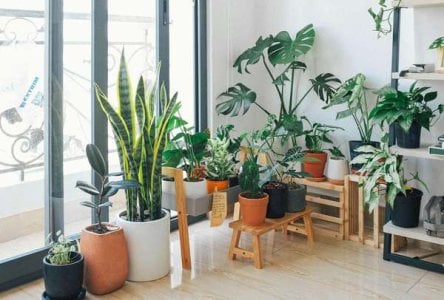Exposed: How Your House-Plant Obsession Is Destroying the Environment!
By
Danielle F.
- Replies 3
The humble house-plant, once a simple addition to homes for a touch of greenery, has now become a symbol of style and eco-conscious living. But behind the lush leaves and Instagram-worthy arrangements lies a darker tale of environmental degradation and species endangerment. The latest victim? A family of cacti known as Copiapoa, which is now teetering on the brink of extinction due to a burgeoning consumer craze for ornamental house plants.
The International Union for Conservation of Nature (IUCN) has sounded the alarm, revealing a disturbing trend in the illegal trade of these spiky desert dwellers. Over 80 percent of Copiapoa species are in trouble, with poachers ransacking fragile landscapes to meet the insatiable demand of collectors worldwide. These cacti, known for their flowering, pudgy, and spikey appearance, often grow in clusters, making them a fashionable decor item in homes across Asia and Europe. However, their rightful place is in the desert of Chile, not perched on windowsills thousands of miles away.
The IUCN's recent update to its Red List of threatened species paints a grim picture: 82 percent of Copiapoa are now threatened, a significant increase from 55 percent just 11 years ago. This spike in vulnerability is a direct result of the illegal trade, which sees poachers digging up these plants, destroying the surrounding landscape, and then listing them for sale in international online markets.
But how can one tell the difference between a legally sourced cactus and one that's been poached from its natural habitat? Pablo Guerrero, a member of the IUCN SSC Cactus and Succulent Plant Specialist Group, explains that it's quite simple. Poached Copiapoa have a grey tone and are coated in a dusty-looking bloom that protects them in one of the driest deserts on Earth. In contrast, cultivated plants appear greener and lack the dusty coating.
The plight of the Copiapoa is not just a story of illegal poaching. These cacti, which comprise 32 species, are also facing threats from development and climate change across their home range in the Atacama coastal desert—a 1,600-kilometre-long strip west of the Andes Mountains. As their environment changes and their numbers dwindle, the future of these unique plants hangs in the balance.
So, what can we, as plant lovers and environmentally conscious individuals, do to help? First and foremost, we must be vigilant about the sources of our house plants. Always purchase from reputable nurseries that can certify their plants have been raised in greenhouses and not taken from the wild. Additionally, we can support conservation efforts and organizations working to protect endangered species and their habitats.
Our love for the weird and wonderful plants of the world should not come at the cost of their survival. By making informed choices and spreading awareness, we can ensure that our green-thumbed hobbies contribute to the preservation of the planet's biodiversity, rather than its destruction.

We invite you to join the conversation and share your thoughts on this pressing issue. Have you ever encountered a poached plant for sale? How do you ensure that your plant purchases are ethical and sustainable? Share your experiences and tips with the Seniors Discount Club community in the comments below. Together, we can cultivate a greener, more responsible approach to our house-plant obsession.
The International Union for Conservation of Nature (IUCN) has sounded the alarm, revealing a disturbing trend in the illegal trade of these spiky desert dwellers. Over 80 percent of Copiapoa species are in trouble, with poachers ransacking fragile landscapes to meet the insatiable demand of collectors worldwide. These cacti, known for their flowering, pudgy, and spikey appearance, often grow in clusters, making them a fashionable decor item in homes across Asia and Europe. However, their rightful place is in the desert of Chile, not perched on windowsills thousands of miles away.
The IUCN's recent update to its Red List of threatened species paints a grim picture: 82 percent of Copiapoa are now threatened, a significant increase from 55 percent just 11 years ago. This spike in vulnerability is a direct result of the illegal trade, which sees poachers digging up these plants, destroying the surrounding landscape, and then listing them for sale in international online markets.
But how can one tell the difference between a legally sourced cactus and one that's been poached from its natural habitat? Pablo Guerrero, a member of the IUCN SSC Cactus and Succulent Plant Specialist Group, explains that it's quite simple. Poached Copiapoa have a grey tone and are coated in a dusty-looking bloom that protects them in one of the driest deserts on Earth. In contrast, cultivated plants appear greener and lack the dusty coating.
The plight of the Copiapoa is not just a story of illegal poaching. These cacti, which comprise 32 species, are also facing threats from development and climate change across their home range in the Atacama coastal desert—a 1,600-kilometre-long strip west of the Andes Mountains. As their environment changes and their numbers dwindle, the future of these unique plants hangs in the balance.
So, what can we, as plant lovers and environmentally conscious individuals, do to help? First and foremost, we must be vigilant about the sources of our house plants. Always purchase from reputable nurseries that can certify their plants have been raised in greenhouses and not taken from the wild. Additionally, we can support conservation efforts and organizations working to protect endangered species and their habitats.
Our love for the weird and wonderful plants of the world should not come at the cost of their survival. By making informed choices and spreading awareness, we can ensure that our green-thumbed hobbies contribute to the preservation of the planet's biodiversity, rather than its destruction.
Key Takeaways
- A consumer craze for ornamental house plants has put the Copiapoa cacti family at the brink of extinction due to illegal trade.
- Over 80 per cent of Copiapoa species are threatened, largely because poachers are ransacking their native Chilean desert habitat for online sales.
- The International Union for Conservation of Nature has updated its Red List, showing a significant increase in the threat level to Copiapoa cacti.
- Collectors can distinguish poached cacti from greenhouse-raised plants by their grey tone and dusty-looking bloom, while cultivated ones appear greener.








